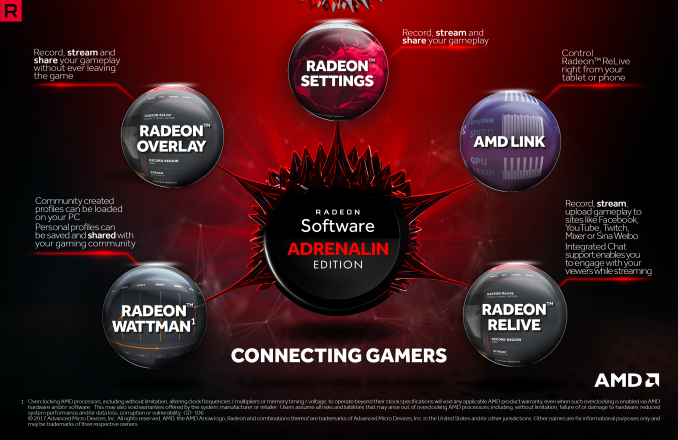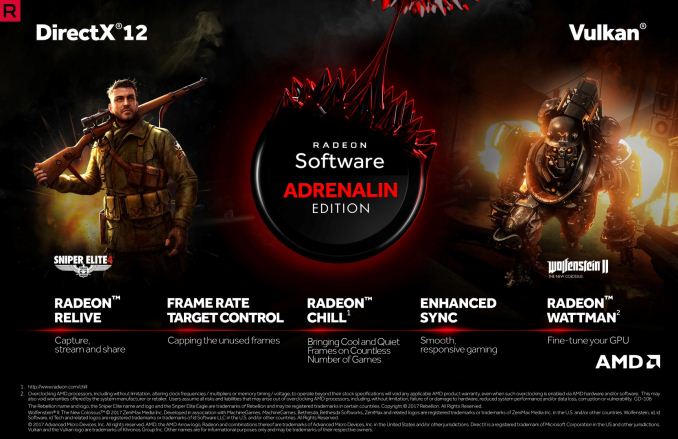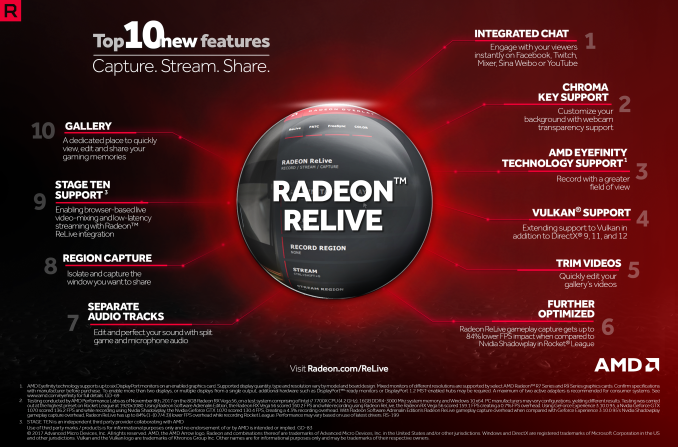AMD Releases Radeon Software Adrenalin Edition: Overlay, App & More for 2017
by Nate Oh on December 12, 2017 9:00 AM ESTFinal Thoughts
To preface, a list of resolved issues was not provided before today’s launch. Glancing over the release notes, a few snippets were not included in the presentations or press releases. FreeSync 2 display support for HDR10 titles is a notable one, considering that we have not heard much since the original announcement of the initiative. Other than the two Samsung monitors, we've only covered an AOC announcement on displays due in April 2018. And of course, the list of bug fixes include several resolutions that users have clamored for in the past couple months.
As for Adrenalin Edition proper, the streaming focus tends to take center stage with Radeon Overlay, AMD Link, and the ‘Connect Tab’. The community angle is more of an accessory to the streaming attributes.
The core features updates and Vulkan emphasis does make Adrenalin useful for general users, but the increased social focus and streaming/sharing integration brings GeForce Experience and ShadowPlay to mind. For streamers, the combination of AMD Link on a tablet/smartphone, Radeon Overlay, and ReLive Adrenalin seems like it could positively impact workflow, particularly if they are doing it casually.
In gauging AMD Link especially, there seems to be some reasonable use cases beyond streaming. For social gamers who want to send screenshots or instant replays of everything to everyone, AMD Link provides that quick option during a respawn timer or end-of-round. It also provides an easy way to post in-game videos or pictures to social media.
In most cases, users will have their phone nearby when on a desktop or laptop, and AMD Link can turn that into a ‘free screen’ for performance monitoring if desired. For laptops and similar situations where screen space is at a premium, this would be a good alternative to an OSD that would show up too small anyway. In all of those scenarios, though, the newsfeed seems superfluous.
Offhand, considering a Radeon Pro Software ReLive and hypothetical AMD Pro Link might have some interesting business functionality. But at the very least, AMD has come very far since even Raptr and Gaming Evolved, and at the same time cut down a few excess syllables to their display driver name.
For both Crimson ReLive and 17.7.2, we reiterated the importance of execution. With Adrenalin, AMD has made the UX much more consistent across different products and configurations. From last year, ReLive is continuing to accumulate better features and find a stronger niche with Radeon Overlay and AMD Link; though in practice this mostly depends on how streamers and social gamers take to it.
On the feature side, Adrenalin is another solid entry for AMD and RTG’s annual major updates. But AMD’s first high-end card launch in two years, especially one featuring a new forward-looking microarchitecture, is not irrelevant to even feature updates, and graphics software is not totally divorced from the hardware itself; a good UX at the least complements the hardware. Users are still inquiring about the RX Vega hardware features, which has affected their expectations of Adrenalin Edition and presumably their present response to it. Consumers still recognize that Adrenalin Edition is a driver that includes performance improvements.
The new Radeon Software Adrenalin Edition 17.12.1 drivers are available through the Radeon Settings tab or online at the AMD driver download page. More information on this update and further issues can be found in the Radeon Software Adrenalin Edition 17.12.1 release notes.



















42 Comments
View All Comments
MajGenRelativity - Tuesday, December 12, 2017 - link
I appreciated the detailed look at all the new features in this driver update! Thank you for the well written articleNate Oh - Tuesday, December 12, 2017 - link
You're welcome, thanks for the compliments :)Manch - Tuesday, December 12, 2017 - link
New acronym: AMDRSAE17MFUjjj - Tuesday, December 12, 2017 - link
2017 has been the worst year for GPUs in a long time.Even when excluding the mining turbulence, the way perf per $ has evolved is just really poor. AMD screwed up with Vega, 1 year late and every metric a disaster while Nvidia has no reason to do more. Granted, memory prices are a substantial headwind too.
Worst case scenario, this is the beginning of the end for PC gaming, if there is no competitive pressure, if memory prices don't come down (or alternative solutions are explored), GPU makers might focus more on pushing prices up than on keeping the market alive- kinda like Intel did since Nehalem.
Ofc to be fair the the pC dies soon enough anyway so it doesn't matter all that much how this racket goes.
Flunk - Tuesday, December 12, 2017 - link
Nvidia was never releasing a new card this year, Volta was always scheduled for next year regardless of what AMD did. Vega was about a year late, yes, but hit all the targets. It would only disappoint you if you weren't paying any attention to anything. The topline Vega card was meant to compete with GTX 1080 and it does. GPU prices are up due to altcoin miners buying them up, that's probably just a temporary thing because either that will die down or someone will make an ASIC for whichever algorithm is hottest.As for this being "the end of PC gaming", PC game sales are up even forcing many formerly console-exclusive developers to release games on PC like Bungie, Rockstar and Capcom. I'd say we're probably seeing the begin of the end of console gaming, but PC and mobile are doing better than ever.
jjj - Tuesday, December 12, 2017 - link
Nvidia had a lot of room to lower prices and add more SKU if needed, they got stupid high margins now because AMD has made a mess. The 1070 would be 250$ today if Vega was competitive.As for Vega, it's terrible in perf per W, perf per mm2 and much worse in perf per cost(note that cost and price are 2 different things). Vega 64 and 56 are a disaster for gaming and you are the one that lacks a clue, or objectivity.
I did mention the mining thing and noted that even when excluding that but you are clearly unwilling to be rational.
As for the end of PC gaming, again you seem to hit certain limitations. Folks buy new GPUs because GPU makers have been able to provide 30-50% more perf per $ every year, if that changes, GPU sale tank, PC gaming becomes a less interesting and evolves much slower and so on. The end is near anyway as glasses will kill PCs, phones and much more in the next decade.
BigCapitalist - Tuesday, December 12, 2017 - link
Please don't be an idiot.What about CPUs? AMD just made Intel get off their asses and they have a $15 BILLION R&D vs AMD Market Cap of $10 BILLION.
So quit blaming AMD for crap, they're stretched as is and YOU are the reason PC gaming will die. People like you care about Watts like you live in a 3rd world country. AMD doesn't have the capability money wise to focus on power draw, it's pretty obvious.
They're fighting Nvidia AND Intel and they're actually doing well against Nvidia right now but all you do is look at the majestic 1080ti(which wasn't the goal anyways) and power draw.
I'm for companies that are pro consumer, Intel and Nvidia aren't, hence the crap performance gains of Intel CPUs for he last 5+ years and Nvidia making you pay for $100 Gsync.
Also, I take it you don't pay attention to the developer side of the market. AMD offers WAY more power than Nvidia for Pro cards vs Quadro for HALF THE PRICE. But people like you just keep buying Nvidia because of the name, hurting the competition which is providing better resources. And in terms of development on games, there hasn't been a better time for them with all the new tools and softwares that are out now, coupled with the raw CPU power of Ryzens up to 16 cores and we have machines that can produce AAA level games on a $3,000 PC.
lmcd - Tuesday, December 12, 2017 - link
Look, AMD is an excellent value proposition for certain compute situations within environments where power is not a constraint.It also is a great option to support open source, if that's your thing.
Small cases are in vogue. If I'm picking between a GTX 1070 and a Radeon 56 for my Silverstone SG09 (mATX case that's slightly larger than the original BitFenix ITX), it's pretty easy to pick the GTX 1070 -- it's cheaper, performs very similarly, and is available in ITX-sized cards.
That said, with how the ReLive software is shaping up, I think that streamers should strongly consider AMD cards and using ReLive instead of managing OBS directly.
mkruzel - Thursday, December 14, 2017 - link
AMD does have very power efficient hardware available. My server is running AMD 3950 (15W) CPU and my desktop runs RX560 (40W) which is good enough for my gaming.MamiyaOtaru - Tuesday, December 12, 2017 - link
"People like you care about Watts like you live in a 3rd world country."haha wut. I care about watts because more of them is harder to cool. Fewer of them means a quieter machine.